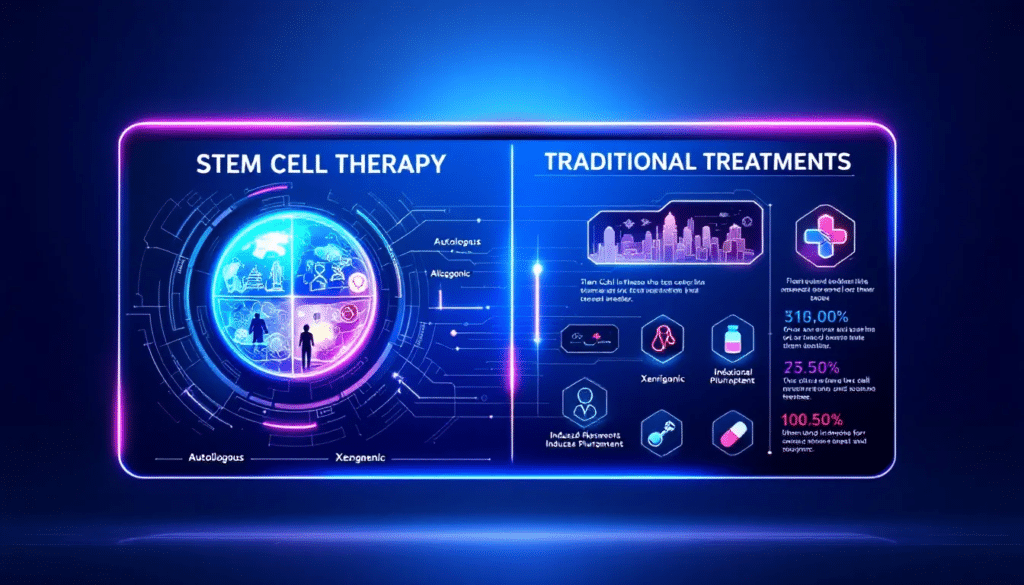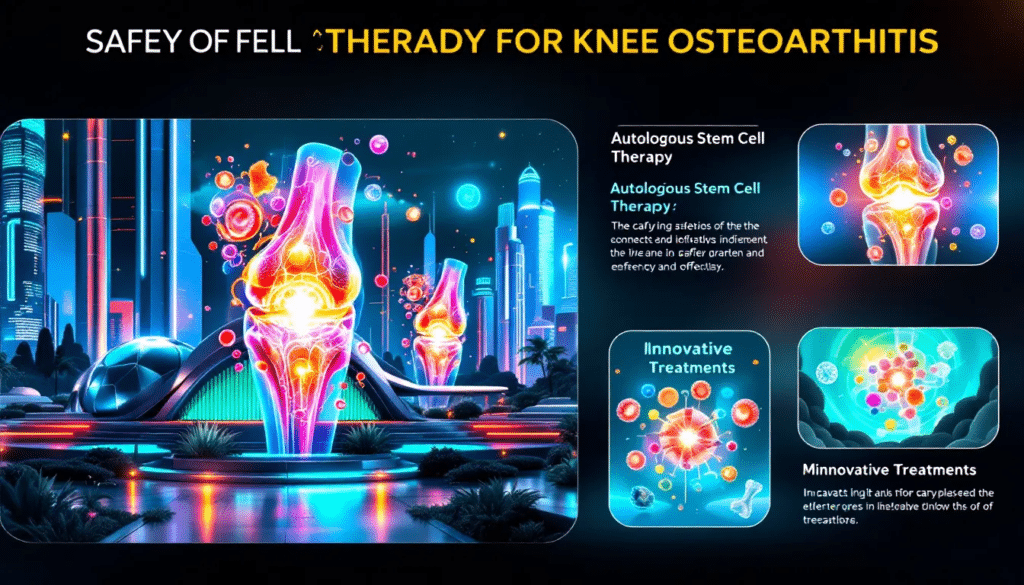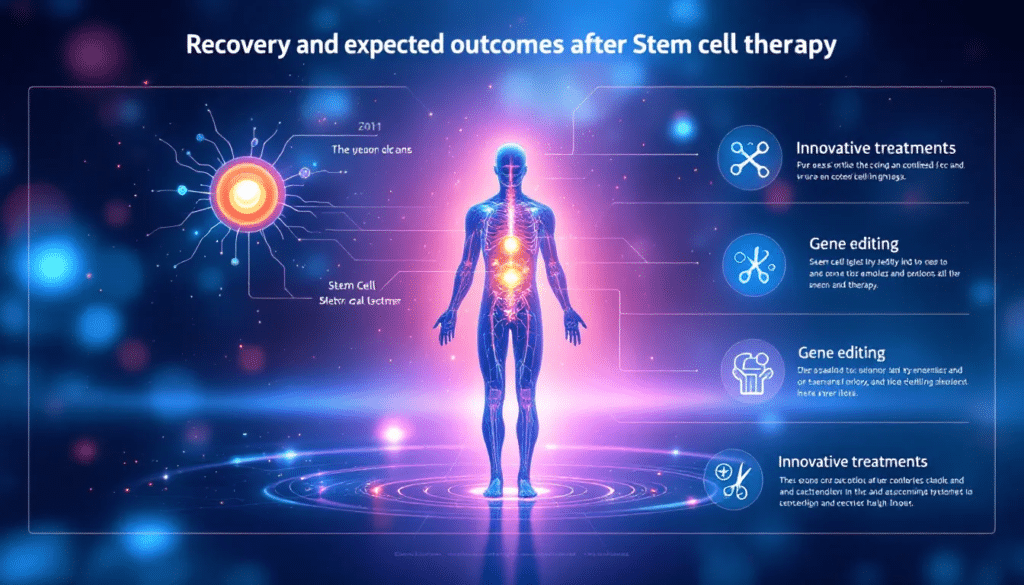If you’re struggling with knee pain from osteoarthritis, stem cells knee therapy could be a viable option. This treatment harnesses the body’s own cells to repair and regenerate knee tissues, potentially providing pain relief and improved function. In this article, we will explain how stem cells are used in knee therapy, compare it to traditional treatments, and discuss its benefits. Learn why more people are considering this innovative option.
Key Takeaways
Stem cell therapy utilizes mesenchymal stem cells to promote tissue regeneration and reduce inflammation, offering significant pain relief for knee osteoarthritis.
Autologous stem cells provide a safer treatment option due to lower risks of rejection, while allogeneic stem cells offer a consistent source for patients who may not qualify for autologous therapy.
Despite being an out-of-pocket expense and lacking major insurance coverage, stem cell therapy is generally more cost-effective than knee replacement surgery and may lead to improved recovery outcomes.
Understanding Stem Cells and Their Role in Knee Therapy

Stem cells are unique, undifferentiated cells with the extraordinary potential to transform into various types of cells in the body. This ability makes them invaluable in regenerative medicine, particularly in treating conditions like knee osteoarthritis. Adult stem cells, including those derived from adipose tissue and bone marrow, are commonly used in knee therapy. These cells can differentiate into chondrocytes, the cells responsible for producing cartilage tissue, which is crucial for restoring joint function and alleviating pain.
In the realm of regenerative orthopedics, stem cells are a game-changer. They enable the body to heal itself by promoting the growth of new, healthy tissue. This process involves concentrated regenerative cells and growth factors that aid in repairing damaged tissues, such as those found in osteoarthritic knees. Harnessing these cells, stem cell therapy presents a promising alternative to traditional treatments that typically manage symptoms instead of addressing the root cause.
The use of stem cells in knee therapy is a testament to the advancements in medical science. These cells’ ability to regenerate damaged cartilage opens up new possibilities for treating knee pain and improving joint function. Exploring how stem cell therapy alleviates knee pain reveals why this treatment is gaining traction among both patients and medical professionals.
How Stem Cell Therapy Alleviates Knee Pain

Stem cells are injected into an arthritic knee joint. They attach to the damaged tissue and sense the local microenvironment. This interaction triggers the release of various bioactive molecules that enhance healing and tissue regeneration. These molecules include growth factors and proteins that play a crucial role in repairing damaged tissues, such as cartilage, tendons, and ligaments.
One of the significant advantages of stem cell therapy is its ability to reduce inflammation, which is a primary source of pain in osteoarthritis. Stem cells release anti-inflammatory factors and extracellular vesicles that help to mitigate inflammation and protect the cartilage from further damage. This reduction in inflammation not only alleviates pain but also helps to slow down the progression of the disease, offering patients a reprieve from chronic knee pain.
Stem cell therapy for knee pain offers several benefits over traditional treatments. It reduces pain and swelling and also improves activity levels, potentially delaying the need for knee surgery. Conditions such as osteoarthritis, tendon injuries, ligament injuries, and meniscus tears can all benefit from this innovative treatment.
Exploring the different types of stem cells used in knee therapy provides a better understanding of why this approach is becoming a preferred option for many patients.
Types of Stem Cells Used in Knee Therapy
Stem cell therapy for knee pain primarily involves the use of mesenchymal stem cells (MSCs), which are known for their ability to transform into various cell types, aiding in tissue regeneration. These stem cells can be sourced either from the patient’s own body (autologous) or from a donor (allogeneic).
Each type has its own set of advantages and potential risks, which we will explore in the following subsections.
Autologous Mesenchymal Stem Cells
Autologous mesenchymal stem cells are harvested from the patient’s own tissues, such as bone marrow or adipose (fat) tissue. This process of using one’s own cells minimizes the risk of rejection and complications, making it a safer option compared to allogeneic stem cells. The harvested cells are then processed and injected back into the knee joint through mesenchymal stem cells injection to promote healing and tissue regeneration.
Patients undergoing autologous mesenchymal stem cell therapy often report significant improvements in joint mobility and pain relief. Leveraging the body’s own healing mechanisms, this therapy provides a promising advancement in treating knee osteoarthritis effectively. Using autologous cells ensures compatibility and optimal healing, making it a preferred choice for many patients.
Allogeneic Stem Cells
Allogeneic stem cells are derived from a donor, providing a potentially more consistent and potent source of stem cells. This option can be particularly beneficial for patients who may not be suitable candidates for autologous stem cell therapy due to various health reasons. The use of donor cells can lead to easier access and availability, expanding the range of patients who can benefit from stem cell therapy.
However, allogeneic stem cell therapy does come with its own set of risks, such as the potential for immune rejection and the transmission of infections. To mitigate these risks, thorough screening and compatibility testing are essential.
Despite these challenges, allogeneic stem cells offer a viable alternative for patients seeking relief from knee pain through regenerative medicine.
Comparing Stem Cell Therapy to Traditional Treatments

Stem cell therapy offers a less invasive alternative to traditional treatment of knee conditions, such as knee replacement surgery. While knee replacement surgery can effectively address severe joint damage, it comes with significant risks, including infection and blood clots. In contrast, stem cell therapy targets the root causes of knee pain, promoting healing and tissue regeneration.
Patients who undergo stem cell therapy typically report lower pain levels and improved mobility compared to those who opt for knee replacement surgery. Additionally, the recovery time for stem cell therapy is generally shorter, allowing patients to return to their normal activities more quickly. This quicker recovery time and lower risk profile make stem cell therapy an attractive option for many patients.
Recent advancements in stem cell therapy have introduced viable alternatives to conventional surgeries. With ongoing exploration and refinement of these treatments, patients now have more options to consider when addressing their knee pain. Knowing the differences between these treatment options can help patients make informed decisions about their healthcare.
The Procedure: What to Expect During Stem Cell Injections
The procedure for stem cell therapy begins with the extraction of stem cells from the patient’s body. This can be done through bone marrow aspiration or harvesting from placental tissue and amniotic fluid. For bone marrow-derived stem cells, the extraction is performed by aspirating bone marrow from the pelvis. Stem cell treatment can be an effective option for various medical conditions.
After collecting the stem cells, they are processed and injected into the knee joint to stimulate cartilage regeneration and reduce inflammation. The procedure typically involves local anesthesia to ensure minimal discomfort for the patient. The entire process usually takes about two hours, allowing patients to go home the same day.
Patients often experience minimal discomfort during the procedure and can resume their normal activities within a few days. The use of ultrasound guidance ensures accurate placement of the stem cells, maximizing the effectiveness of the treatment. Knowing what to expect during the procedure can help alleviate any concerns and prepare patients for a smooth experience.
Who is an Ideal Candidate for Stem Cell Therapy?
Ideal candidates for stem cell therapy are those in good overall health, as this ensures the body can handle the treatment effectively.
Patients with:
severe anemia
bone marrow cancer
active infections
other serious health issues
are not suitable candidates for stem cell therapy.
The therapy is most beneficial for individuals whose medical condition has not reached an advanced stage.
Doctors consider several factors when determining a patient’s eligibility, such as the severity of the injury or chronic condition, age, and the condition of the body’s stem cells. Candidates with realistic expectations and an understanding of the treatment’s potential and limitations are more likely to benefit from stem cell therapy.
A thorough medical evaluation is crucial to ensure the treatment’s effectiveness and determine the right course of action.
Safety and Efficacy of Stem Cell Therapy for Knee Osteoarthritis

Research indicates that stem cell therapy can lead to significant pain reduction and improved joint function for individuals suffering from knee osteoarthritis. Studies indicate that mesenchymal stem cell therapy enhances joint mobility and reduces pain, making it an effective conservative treatment for knee osteoarthritis. The therapy has a generally safe profile with minimal risk of adverse reactions.
Adverse events associated with stem cell therapy, like joint effusion, stiffness, and pain, are generally infrequent. Meta-analyses have emphasized the need for high-quality, large-scale randomized controlled trials to confirm these findings.
Overall, the safety and efficacy of stem cell therapy make it a viable treatment option for those seeking relief from chronic knee pain.
Cost of Stem Cell Therapy for Knee Pain
The cost of stem cell therapy for knee pain can vary widely, typically ranging between $3,000 and $5,000 per knee, depending on individual needs and provider location. A single stem cell injection may cost around $4,200, while treatment for both knees can total approximately $5,000. Patients often have to pay out-of-pocket for this therapy, with costs influenced by factors such as the healthcare provider, geographical location, and the unique requirements of the patient.
While the cost of stem cell therapy may seem high, it is generally lower than the cost of knee replacement surgery, which may require multiple treatments. Financing options such as CareCredit are available to help manage these expenses. Knowing the cost structure and available payment options can help patients plan for their treatment effectively.
Insurance Coverage and Payment Plans
Currently, stem cell treatments for the knees are not covered by major insurance carriers due to the lack of FDA approval. Insurance companies classify stem cell therapy as ‘experimental and investigational,’ leading to widespread denial of coverage. Some specific types of insurance plans might cover stem cell therapies if deemed medically necessary, but elective treatments are mostly not covered.
Medicare does cover certain stem cell transplants but not therapies for degenerative conditions like knee arthritis. Consequently, most patients need to pay cash for stem cell knee therapy. Payment options like CareCredit are widely accepted, offering patients flexible financing solutions to manage the costs associated with stem cell therapy.
Recovery and Expected Outcomes

The initial recovery phase after stem cell therapy emphasizes rest for one to two days, allowing the body to recover. Within four to seven days, patients can typically resume normal activities, although they should avoid anti-inflammatory medications to preserve stem cell function. Significant inflammation in the treated area is common in the first two weeks post-treatment due to immune activity.
Most patients report mild improvement from the therapy at one month, with significant improvement observed between two to three months. By weeks three to four, low-impact exercises are recommended to enhance mobility without stressing the healing tissues. Long-term studies suggest that stem cell therapy may slow the progression of osteoarthritis, offering a promising outlook for patients seeking lasting relief from knee pain.
Real patient testimonials highlight the effectiveness of stem cell therapy. For instance, Elsie reported an 80-90% improvement in functionality, allowing her to perform daily tasks without pain medication. Another patient, Liz, canceled her planned knee replacement after experiencing significant pain relief and improved function from stem cell therapy. These stories underscore stem cell therapy’s potential to transform the lives of those suffering from knee osteoarthritis.
Real Patient Experiences
Real patient experiences provide invaluable insights into the effectiveness of stem cell therapy. One patient described their knees feeling significantly younger and much improved after five months of recovery. Profound improvements in knee functions and the ability to resume normal activities like walking and exercising have been reported by many patients.
Numerous patients have shared positive experiences regarding their stem cell therapy for knee pain, noting significant improvements in their conditions. These improvements lead to enhanced quality of life, allowing patients to engage in daily activities they once struggled with.
The general satisfaction among patients who have undergone stem cell therapy underscores its potential as a transformative treatment for knee pain.
Summary
Stem cell therapy for knee osteoarthritis represents a revolutionary approach in regenerative medicine, offering significant pain relief and improved joint function. By harnessing the body’s natural healing mechanisms, stem cell therapy addresses the root causes of knee pain, providing a less invasive alternative to traditional treatments like knee replacement surgery. The procedure is generally safe, with minimal risks and a quicker recovery time.
As research continues to advance, stem cell therapy holds the promise of becoming a mainstream treatment option for knee osteoarthritis. Patients who have undergone this therapy report life-changing improvements, enabling them to return to their normal activities and enjoy a better quality of life. The future of knee pain treatment looks brighter with the advent of stem cell therapy, opening new doors to healing and recovery.
Frequently Asked Questions
What are stem cells, and how do they help in knee therapy?
Stem cells are undifferentiated cells capable of developing into different cell types. In knee therapy, they aid in regenerating damaged cartilage, reducing inflammation, relieving pain, and enhancing joint function.
How does stem cell therapy alleviate knee pain?
Stem cell therapy alleviates knee pain by promoting tissue repair and reducing inflammation through the release of bioactive molecules that stimulate the growth of new, healthy cells. Consequently, this therapy can enhance mobility and provide significant pain relief.
What are the types of stem cells used in knee therapy?
Autologous mesenchymal stem cells, derived from the patient’s own tissues, and allogeneic stem cells, sourced from a donor, are the main types of stem cells used in knee therapy. Each type presents unique benefits and potential risks that should be carefully considered.
How much does stem cell therapy for knee pain cost?
Stem cell therapy for knee pain generally costs between $3,000 and $5,000 per knee. This amount may vary based on individual circumstances and provider location, with many patients financing the treatment out-of-pocket.
Is stem cell therapy covered by insurance?
Stem cell therapy is generally not covered by major insurance carriers, as it is considered ‘experimental and investigational.’ Patients typically must pay out-of-pocket, though financing options may be available.


